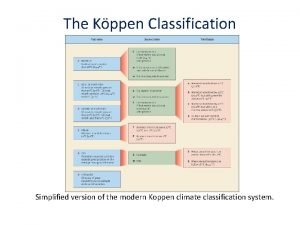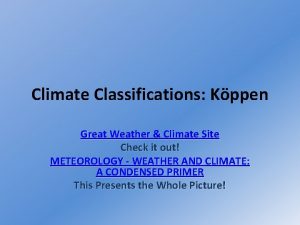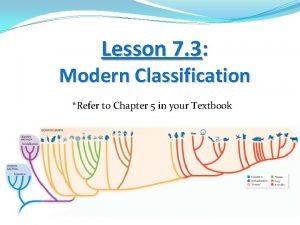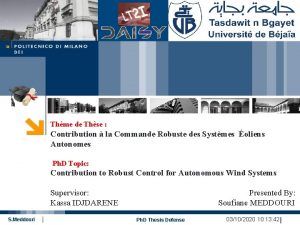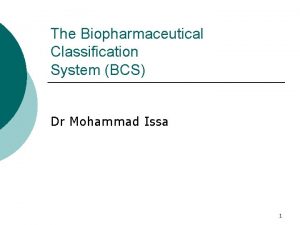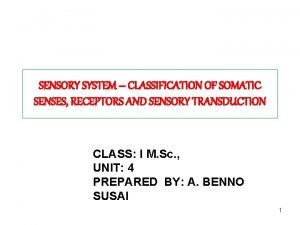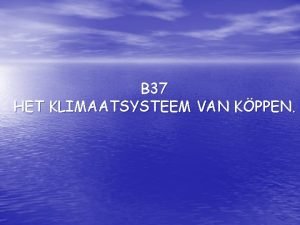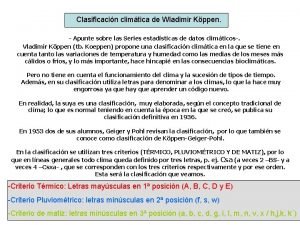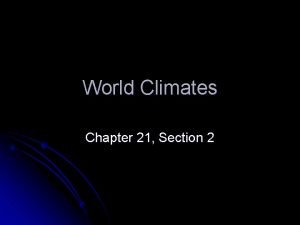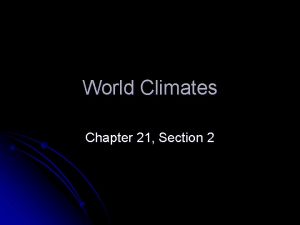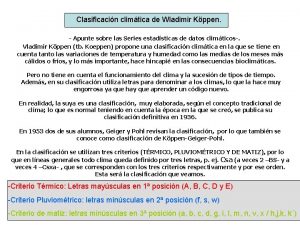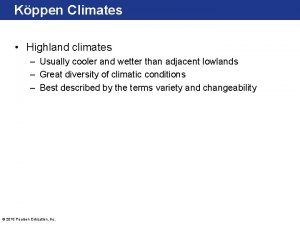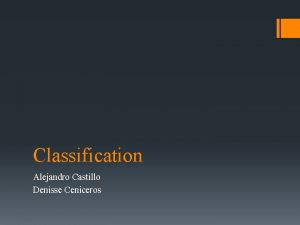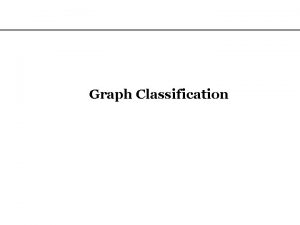Kppen Classification System 90 60 30 60 90


















- Slides: 18

Köppen Classification System

90 60 30 60 90

Climate Classification Looks At… • Atmosphere • Hydrosphere • Geosphere • Biosphere • Cryosphere

In your groups, read about your assigned climate and present the following to the rest of the class: • Name and Letter of your climate • Description of the main climate type • Atmosphere • Hydrosphere • Geosphere • Biosphere • Cryosphere (if applicable) • Any subgroups of your climate, including descriptions • General latitudes where this climate is found • Relationship to high or low pressure

Humid Tropical - A • Temperatures average around 25 C or more each month • Very small temperature range • Yearly precipitation is high – usually more than 200 cm • All months are wet – if there is a dry season, it is very short • Found along equator

Humid Tropical - A • Wet Tropics • Af – every month has 6 cm or more of precipitation • Am – Short dry season • Tropical Wet and Dry • Aw – Well-defined winter dry season • As – Well-defined summer dry season

Dry - B • Potential evaporation exceeds precipitation • Very little, if any, precipitation each year • Found between 20 -30 N and 20 -30 S • Steppe – BS – Semi-arid – slightly more humid • Desert – BW - Arid

Humid Middle-Latitude with Mild Winters - C • Average temperature of coldest month is under 18 C and above -3 C • Typically in sub-tropical regions – 30 -60 N and 30 -60 S

Humid Middle-Latitude with Mild Winters - C • Dry-Summer Subtropics – Csa, Csb • West sides of Continents • Dry summers • Also called Mediterranean Climate

Humid Middle-Latitude with Mild Winters - C • Humid Subtropical – Cfa • Southeastern US • Hot, humid summers • Afternoon and evening thunderstorms likely • Winters are drier, frost possible

Humid Middle-Latitude with Mild Winters - C • Marine West Coast – Cfb • Western side of continents • Dominated by onshore flow of oceanic air • Mild winters, cool sumers • Ample rainfall year round

Humid Middle-Latitude with Severe Winters - D • Characterized by extreme winters • Land-controlled climates • Absent in the Southern Hemisphere

Humid Middle-Latitude with Severe Winters - D • Humid Continental – Dfa, Dwa • Central and eastern portions of North America • Winter and summer temperatures considered severe • Generally more precipitation in the summer

Humid Middle-Latitude with Severe Winters - D • Subarctic – Dfc • Often referred to as the taiga • Winter is considered dominant • Warm, short summers • Produce the highest annual temperature ranges • Low annual precipitation

Polar - E • Mean temperature of the warmest month is below 10°C (50°F) • Temperatures in the summer are still cool • Low water vapor in the air • Low precipitation • Low evaporation

Polar - E • Tundra Climate – ET • Treeless climate • Almost exclusively found in Northern Hemisphere • Winters are severe, summers are cool • High annual temperature ranges • Low precipitation

Polar - E • Ice Cap Climate– EF • Does not have a single monthly mean above 0°C • No vegetation growth • Permanent ice and snow • Confined to the ice sheets of Greenland Antarctica

Highland - H • Cooler and wetter than nearby places because of higher altitude • Seasonal temperature cycles are similar to the surrounding areas • Slope and orientation to the sun also affect temperature and moisture
 Kppen
Kppen Kppen
Kppen Tropical monsoon climate characteristics
Tropical monsoon climate characteristics Eager learning
Eager learning Quantitative classification in statistics
Quantitative classification in statistics Traditional classification vs modern classification
Traditional classification vs modern classification Is earth a closed system or open system
Is earth a closed system or open system Respiratory digestive and circulatory system
Respiratory digestive and circulatory system Apg system of classification
Apg system of classification Baltimore classification system
Baltimore classification system Ao classification system
Ao classification system Classification of energy storage system
Classification of energy storage system Biopharmaceutical classification
Biopharmaceutical classification Bcs is
Bcs is Diagram takhtajan system of classification
Diagram takhtajan system of classification Demerits of engler and prantl system of classification
Demerits of engler and prantl system of classification Classification of sensory system
Classification of sensory system Classification of scada system
Classification of scada system Hybris classification system
Hybris classification system
